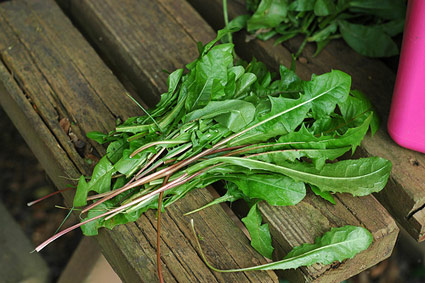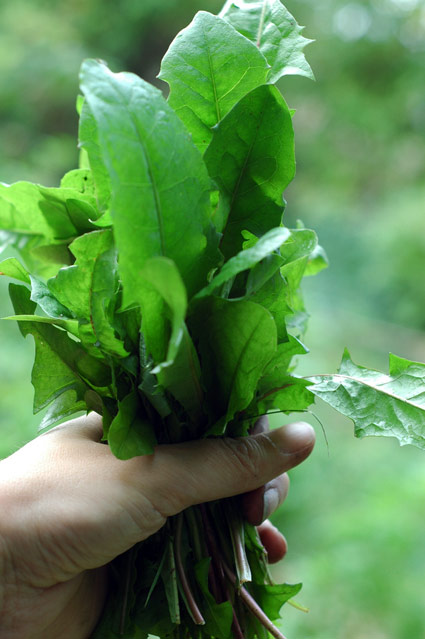
My new plot at the community garden has been a revelation. I have enjoyed my time there and am thoroughly bummed that it will all be done in a month — I don’t want this gardening season to end! The plot is in the sun and has not only opened up new in-ground growing opportunities, but provided a few surprises of its own. Our cool, wet fall (boo) has been the perfect breeding ground for dandelions and they have been coming up both in that plot and the communal herb plot. It’s saddens me that the dandelion is so maligned as a pest. I associate its yellow flowers and puffy seed heads with spring and childhood wishes. I love its toothy leaves that are useful as a healing edible green great for flushing out your kidneys.
Some contempt for the plant is obviously connected to the way it can take over a lawn, which is laughable to me because it is the conditions created by a lawn that allows it to thrive there in the first place. However, I think that a lot of our North American predjudice against the dandelion is culturally embedded, tied up in eliticism, class, and race. I am currently reading the “Autobiography of Malcolm X” and there is a passage near the beginning of the book in which he describes the poverty his family endured after his father was murdered. At one point the family was “reduced” to dinners of boiled dandelion greens and rumours were soon spread that they were eating “fried grass.” This shocked me given that this was rural America in the early 30s. Eating and using dandelion parts is also commonly associated negatively with immigrants. Growing up in Southern Ontario, Canada I can recall many sunny spring days watching old-world Italian women collecting the bright yellow flowers for wine. The women would pick mostly in public parks where dandelions were prolific, while their middle class neighbours would scoff at the primitiveness of it. I discovered an edible weeds book at the library in highschool and became fast obsessed with all of the wild foods growing unawares in public parks, backyards, and cracks in the sidewalks. One particular book (I wish I knew the name) placed each plant into historical context outlining how some plants had been in use abundantly before they became marginalized or passe. It’s shocking to me how much good food is overlooked simply because our ancestors collectively decided it was beneath us.

And so I’ve been collecting the young, tender dandelion greens from my community plot. While the books often state that commercially available varieties tend to be less bitter, I have found that they harvest those when they’re too large and mature. My greens are bitter, but no more so than the arugula. We’ve been able to eat a handful raw and mixed with other greens. I have read that dandelion leaves taste better in the fall than in spring and that may also account for the difference. I am planning to try out this Hortopita recipe using spelt filo. It’s the perfect time since onions and leeks are also in season. Dandelion leaves and roots can also be collected and made into a calcium-rich herbal vinegar. The book, “Herbal, The Essential Guide to Herbs for Living” suggests blanching the leaves right on the plant by inverting a plant pot over the plant and overing the drainage holes with stones. “After a few weeks the leaves turn pale green and lose their bitterness.”
I fully agree! Dandelions are absolutely one of the most not only beautiful, but useful “weeds” around. I only wish they were more prolific here in Northern California. I don’t know how big they get in your neck of the woods, but here the dandelions are quite small and are rarely seen in prolifically growing in fields. When I went to Norway a couple years ago, I was stunned at how large their Dandelions were! It was such a beautiful sight to see these gigantic Dandelions growing in every crevice in Oslo! Here is one of the pictures, not too great a shot of the Dandelions, but some proof enough:
http://www.joeolivas.com/trip/trip-Pages/Image1.html
A teaspoon of that herbal vinegar gives you the equivalent of a glass of milk’s worth of calcium! Fabulous stuff, and tasty, too.
Taryn: They are all different sizes depending on where they are growing and possibly even variety (I have read there are some grown specifically for commercial usuage and a type that has white flowers) but generally they do get that size here and sometimes in the spring there are parks filled with them. Here’s a photo and another.
Very pretty! (I like how the yellow of the flowers is repeated on the building).
Amazing, I had never thought about different varieties. The white ones sound very interesting.
We [in Northern California, natch] have a lawnful left by the previous tenants though they’re the small variety and it would take forever to gather enough leaves to make anything. I definitely associate them with being poor, all the crappy neighborhoods I’ve lived in have been overrun, while you never see them in the hills [where the monied folks live]. I think I read recently that they’re where the phrase ‘gone to seed’ comes from.
Next growing season I want to plant some Dandelion greens. Your greens are big and healthy, where did you buy your seeds. I have seed the small leaves with tiny spikes on them. Dandelion is one of my favorite salad greens.
Our gunea pig loves dandilion greens and really gives us an attitude when we cannot find them at the supermarket. We also put them in salad and now that I have looked online I found that they have many great qualities. My question is the same as Lemongrass’s, where did you get your seeds. I cannot seem to find any and I love to have a garden and would love to be able to grow my own.
Lemongrass and Mollie: A number of people requested this info and I’ve got to say it’s been more difficult to track down seeds than I anticipated. I posted about it here.